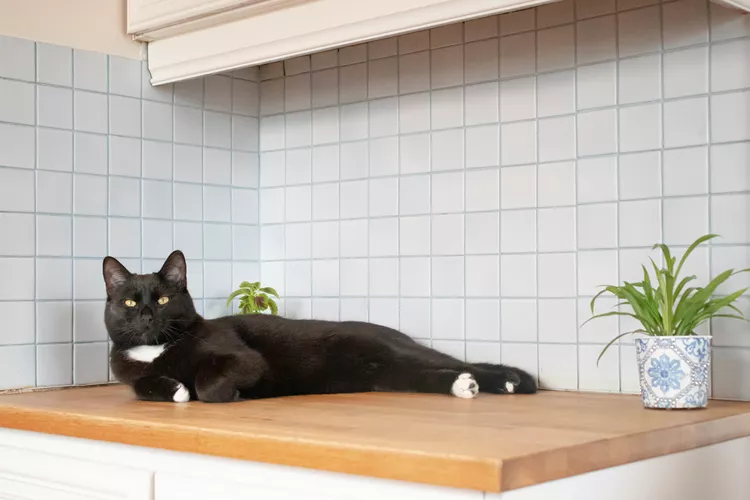
Keeping your cat off the kitchen counters isn't just a way to prevent spills—it could also help prevent injury for your cat and maintain an overall safer environment in the home. Cats who frequently jump on kitchen counters can inadvertently create a number of problems, like injuring themselves while walking on a hot stove or ingesting foods that are toxic to animals.
But the behavior can also create hazards for humans, by tracking waste onto counters if they walk on them after using the litter box and spreading bacteria across the area where food is prepared.
So, how does one try to keep their cat on the ground level? The easiest way is to use a mix of deterrents and rewards.
Kitchen counters attract cats for several reasons. Once you identify the reason your cat likes the countertop so much, you can use this information to modify or redirect your cat's behavior.
Employing a few training techniques will encourage your cat to stay off the countertop. These have proven to be successful, but you must maintain consistency if you want your cat (or cats) to get off and stay off the kitchen countertops.
Try the method that works best for your situation or that your cat responds to most positively.
By using a little ingenuity and staying "one jump" ahead of your cat, you should be able to discourage your kitty's counter-surfing habit.
If nothing seems to work despite your consistency and effort, it may be time to call in a feline behavioral therapist. In this type of situation, the specialist will likely visit your home to assess the situation and come up with new behavior modification techniques to help you keep your cat off the countertop.

Is Neosporin Safe for Cats?
A brief summary of concerns a cat owner should be aware of before putting Neosporin on their cat, plus tips for things they can use at home instead.
18 Warning Signs That Your Cat Is Crying for Help
How can you tell if your cat is sick? Learn about the warning signs indicating your cat is crying for help and find out what to do about them.
Chlamydia in Cats
Chlamydia in cats is a bacterial infection primarily affecting the eyes, which can cause conjunctivitis. Learn the causes, treatment, and prevention.
Why Does My Kitten Bite Me? How to Stop Biting and Scratching in Kittens
Why does your kitten bite you? Play aggression is often the cause, but there may be other reasons for the scratching and biting. Here’s what to do if your cat bites and scratches you, including how to stop it.
200 Tortoiseshell Cat Names for Your Bi-Colored Kitty
Tortoiseshell cats are a rare phenomenon and deserve a fitting name. We've pulled together 200 tortoiseshell cat names, including male names, female names, cute names, and names inspired by their coat color and pattern.
12 Fluffy Cat Breeds Perfect for Endless Cuddles
If you like long-haired cats and don't mind daily (or almost daily) brushing, you’ll love these fluffy cat breeds.
10 Unique Bobtail Cat Breeds
Bobtail cat breeds, including the Manx and Cymric, result from natural genetic mutations. Learn whether one of these cats is right for you.
Burmese: Cat Breed Profile, Characteristics & Care
Known for their loving personality and muscular body, the Burmese loves to cuddle after a bout of kittenish playing. Learn about the Burmese breed.
Turkish Angora: Cat Breed Profile, Characteristics & Care
The elegant and silky Turkish Angora cat is a playful, affectionate, and sometimes mischievous pet. Learn about the Turkish Angora breed.
Why Does My Cat Follow Me Around Everywhere?
Cats can follow their owners around for a few different reasons. Find out what your cat is trying to tell you if they follow you around.
Why Does My Cat Bite My Chin?
If your cat is biting your chin, this might be a sign of affection, but it can also be caused by boredom or stress. Learn how to curb the behavior.
Common Causes of Mucus in Dog Poop
Seeing mucus in your dog's poop can be concerning to a dog owner. Here are common causes and treatment of mucus in a dog's stool.
Why Do Dogs Pant?
Dogs pant for a number of reasons, including cooling, excitement, and play. But sometimes panting is a sign of a physical problem. Learn why dogs pant and what to do about it. Here’s how to tell if your dog’s panting is normal or a sign of a problem.
Intervertebral Disc Disease (IVDD) in Dogs
Intervertebral disc disease (IVDD), or a herniated disc, is a serious condition of the spinal cord. Learn the causes, treatment, and prevention.
Can Dogs Eat Watermelon?
Can dogs eat watermelon? Yes! But its important to keep certain precautions in mind. Learn the benefits, risks, and how to safely feed your dog this fruit.
Border Collie: Dog Breed Characteristics & Care
Learn about the border collie, a popular herding breed. They're a smart and energetic dog that's also a great companion to the right pet parent.
Beagle: Dog Breed Characteristics & Care
Learn about the beagle, one of the most popular dog breeds in the world. They are known for being a cheerful, comical, loud, and energetic family dog.
Bluetick Coonhound: Dog Breed Characteristics & Care
Bluetick Coonhounds are a medium-size hound that are gentle and affectionate. They are commonly used as a raccoon hunting dog.
Tibetan Terrier: Dog Breed Characteristics & Care
The Tibetan terrier is a happy-go-lucky dog with a shaggy coat. Learn more about the history, care tips, and other helpful information about the breed.
Lagotto Romagnolo: Dog Breed Characteristics & Care
The Lagotto Romagnolo is an intelligent working breed from Northern Italy and can be an adaptable and laid back companion breed.